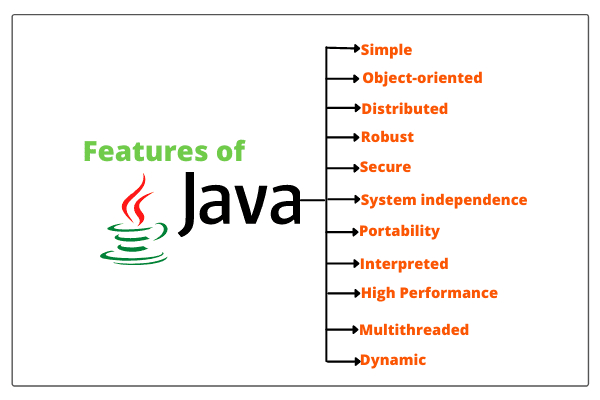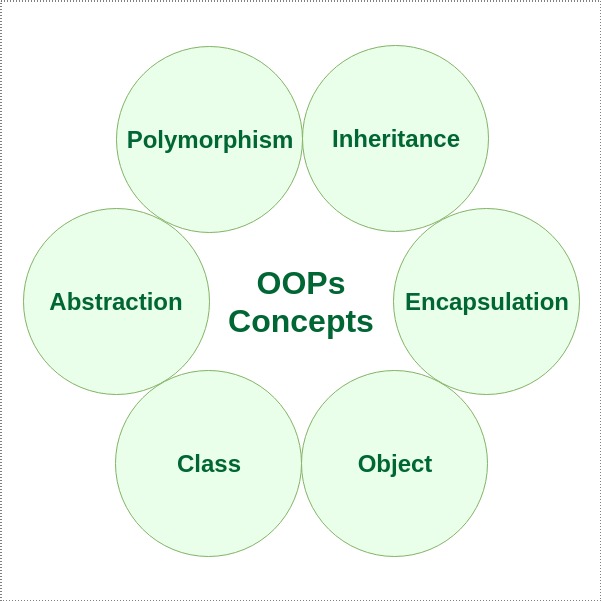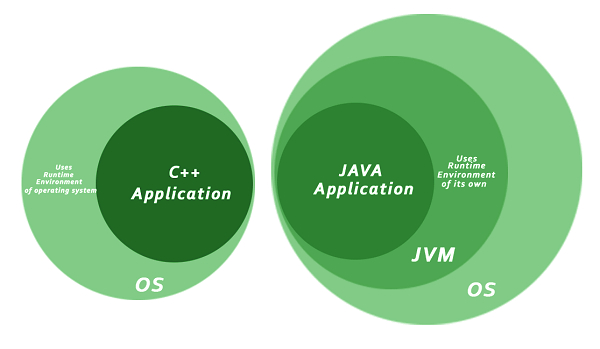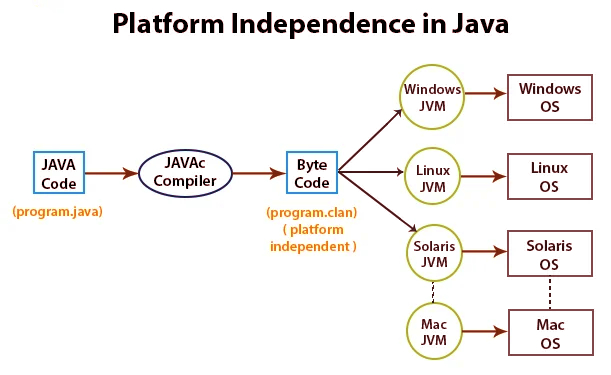Java Features: The Java programming language was created with the primary objective of being a portable, secure, and user-friendly language. These features, known as Java buzzwords, are what have contributed to the language’s widespread popularity.
Below is a list of the key features of Java that have played an important role in making it a popular programming language:
1. Simple
2. Object-Oriented
3. Distributed
4. Robust
5. Secured
6. Platform independent
7. Portable
8. Interpreted
9. High Performance
10. Multithreaded
11. Dynamic
12. Architecture Neutral

1. Simple:
Sun Microsystems stated that Java is a simple programming language because of its easy-to-understand syntax, which is based on C++. This allows programmers who are familiar with C++ to learn Java quickly. Java has also removed many complex and rarely-used features, such as explicit pointers and operator overloading, which further simplifies the language.
Another feature that contributes to Java’s simplicity is its Automatic Garbage Collection. This eliminates the need for programmers to manually remove unreferenced objects, which can be a complex and time-consuming task in other programming languages. Overall, Java’s simplicity has made it an accessible language for beginners and an efficient language for experienced programmers.
2. Object-Oriented:
Java is an object-oriented programming language, which means that it is based on the principles of object-oriented programming (OOPs). In OOPs, the software is organized into a collection of different objects that represent both data and behavior.
This methodology provides a set of rules and guidelines that help simplify software development and maintenance. By organizing code into objects, developers can better manage complex code bases and avoid code duplication. Additionally, OOPs provides features like encapsulation, inheritance, and polymorphism that help make code more modular and easier to understand. Overall, the principles of OOPs have made Java a powerful and versatile language for building a wide range of applications.

The basic concepts of OOPs are:
1. Object
2. Class
3. Inheritance
4. Polymorphism
5. Abstraction
6. Encapsulation
3. Distributed:
Java is known for its ability to support the creation of distributed applications, allowing users to develop software that can be accessed and used from multiple machines on the internet. Java provides tools such as RMI (Remote Method Invocation) and EJB (Enterprise JavaBeans) for building distributed applications.
This feature of Java enables developers to create applications that can access files and resources from any machine connected to the internet, making it a powerful platform for building web-based and networked software systems. Overall, Java’s support for distributed programming has helped make it a popular choice for developing large-scale, complex applications that can be deployed and used across multiple machines and networks.
4. Robust:
Java is considered a robust language due to its strong memory management, automatic garbage collection, and exception-handling mechanisms. Additionally, Java’s lack of pointers helps to prevent common security problems that can arise in other programming languages.
With its robust memory management, Java provides a safe and secure environment for building complex applications, ensuring that memory is allocated and deallocated efficiently. The automatic garbage collection feature further enhances Java’s robustness by removing unused objects from the memory, freeing up system resources.
Moreover, Java’s built-in exception handling and type-checking mechanisms help to identify and handle errors in the code, preventing potential bugs and crashes. Overall, these features have made Java a reliable and robust language for developing a wide range of software applications.
5. Secure:
Java is widely recognized for its strong security features, which have made it a popular choice for developing secure software systems that are less prone to virus attacks and other security threats.
- No explicit pointer
- Java Programs run inside a virtual machine sandbox

- Classloader: The Classloader is a critical component of the Java Runtime Environment (JRE) that is responsible for loading Java classes dynamically into the Java Virtual Machine (JVM). It helps ensure security by isolating locally stored classes from those that are imported from network sources, preventing unauthorized access and protecting against potential security breaches.
- Bytecode Verifier: Another important security feature of Java is the Bytecode Verifier, which is responsible for checking code fragments to identify any illegal code that could potentially violate access rights to objects. By verifying bytecode at runtime, Java can help prevent unauthorized access and protect against potential security threats.
- Security Manager: Java’s Security Manager is responsible for determining what resources a class can access, including reading and writing to the local disk. By carefully controlling access to system resources, Java can help prevent unauthorized access and ensure that applications run securely and smoothly.
6. Platform Independence:
Java is considered a platform-independent language, unlike other programming languages such as C or C++, which are compiled into platform-specific machine code. This is due to the unique design of the Java language, which allows it to be written once and run on multiple platforms.
Unlike hardware-based platforms, which are specific to a particular device or system, the Java platform is a software-based platform that can run on top of various hardware-based platforms. The Java platform consists of two main components: the Runtime Environment and the API (Application Programming Interface).
One of the key advantages of the Java language is its ability to execute code on multiple platforms, including Windows, Linux, Sun Solaris, and Mac/OS. When Java code is compiled, it is converted into bytecode, which is a platform-independent code that can be executed on any platform that supports the Java Virtual Machine (JVM).
This “Write Once, Run Anywhere” (WORA) approach has made Java a popular choice for developing cross-platform applications that can be deployed on a wide range of devices and systems, without the need for significant modifications to the code.

7. Portability:
Java is considered a portable programming language because it allows for the easy transfer of Java bytecode to any platform without requiring any additional implementation steps. This means that Java code can be developed on one platform and then executed on another platform without needing to make significant changes to the code. The portability of Java has made it a popular choice for developing applications that need to run on different platforms and devices.
8. Interpreted:
Java is an interpreted programming language, which means that the code is not compiled into machine language but is instead executed directly by an interpreter. When a Java program is compiled, it is converted into bytecode, which is a platform-independent code that can be executed on any system that has a Java Virtual Machine (JVM) installed.
During the execution process, the interpreter reads the bytecode and executes it line by line, translating it into machine language as needed. This process of interpretation allows for greater flexibility and ease of use, as it allows Java code to be executed on a wide range of platforms without requiring platform-specific modifications or recompilation.
9. High Performance:
Because Java bytecode is “close” to native code, it is faster than other traditional interpreted programming languages. It is nevertheless slightly slower than a compiled language (for example, C++). Because Java is an interpreted language, it is slower than compiled languages such as C, C++, and others.
10. Multi-threaded:
A thread is a separate program that runs concurrently. By designing many threads, we can develop Java programs that handle numerous tasks at once. The main advantage of multi-threading is that each thread does not take up memory. It has a shared memory space. Threads are essential for multimedia, Web applications, and others.
11. Dynamic:
Java is a dynamic programming language that allows for the loading of classes on demand, which is known as dynamic class loading. Additionally, Java supports native functions from languages such as C and C++, making it a versatile language.
Java also includes features such as dynamic compilation and automatic memory management through garbage collection. Dynamic compilation allows the JVM to optimize and compile code during runtime, which can improve performance. Garbage collection automatically manages the memory allocation and deallocation for objects, which simplifies memory management for developers and reduces the risk of memory-related errors.
12. Architecture Neutral
Java is considered architecture neutral since it does not have any features that depend on a specific implementation. This is exemplified by the fixed size of primitive types. For instance, in C programming, the int data type occupies 2 bytes of memory on a 32-bit architecture and 4 bytes on a 64-bit architecture. In contrast, in Java, the int data type occupies 4 bytes of memory regardless of whether the architecture is 32-bit or 64-bit.
Join tutorials.freshersnow.com to explore and learn more like features of Java.
